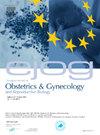Intracavitary-Electrohysterogram: Novel technique for assessing uterine peristalsis and electrophysiology in non-pregnant women
IF 2.1
4区 医学
Q2 OBSTETRICS & GYNECOLOGY
European journal of obstetrics, gynecology, and reproductive biology
Pub Date : 2025-03-17
DOI:10.1016/j.ejogrb.2025.03.042
引用次数: 0
Abstract
Background
Uterine peristalsis plays a crucial role in fertility and is affected by various disorders and pathologies. Its knowledge and assessment are very limited with current monitoring techniques.
Objective
The aim is to objectively and quantitatively characterize menstrual uterine peristalsis using a new technique, intracavitary electrohysterogram (IC-EHG).
Methods
This pilot multicenter study recorded IC-EHG by means of a multipolar catheter in a prospective cohort of 15 healthy women with proven fertility across three menstrual phases: mid-follicular (MF), early luteal (EL), and late luteal (LL). To describe and compare uterine peristaltic patterns, characteristics such as contraction frequency, duration, amplitude, and energy were calculated.
Results
The IC-EHG recordings revealed statistically significant patterns throughout the menstrual phases. Uterine contractions were less frequent (3.2 CT/min), more intense and of longer duration during the MF phase. As the menstrual cycle progressed to the EL and LL phases, the frequency of contractions increased (3.7 and 3.5 CT/min, respectively) while both amplitude and duration declined.
Conclusions
The intracavitary electrohysterogram (IC-EHG) effectively quantifies menstrual cycle-dependent uterine peristalsis and electrophysiological patterns, providing initial reference values for uterine bioelectrical activity in fertile women. This novel technique represents a significant advance in assessing uterine physiology, with potential use as a diagnostic tool for real-time uterine health monitoring, supporting gynecological treatment and planning, and aiding in assisted reproductive technologies through objective metrics of uterine activity.
求助全文
约1分钟内获得全文
求助全文
来源期刊
CiteScore
4.60
自引率
3.80%
发文量
898
审稿时长
8.3 weeks
期刊介绍:
The European Journal of Obstetrics & Gynecology and Reproductive Biology is the leading general clinical journal covering the continent. It publishes peer reviewed original research articles, as well as a wide range of news, book reviews, biographical, historical and educational articles and a lively correspondence section. Fields covered include obstetrics, prenatal diagnosis, maternal-fetal medicine, perinatology, general gynecology, gynecologic oncology, uro-gynecology, reproductive medicine, infertility, reproductive endocrinology, sexual medicine and reproductive ethics. The European Journal of Obstetrics & Gynecology and Reproductive Biology provides a forum for scientific and clinical professional communication in obstetrics and gynecology throughout Europe and the world.

 求助内容:
求助内容: 应助结果提醒方式:
应助结果提醒方式:


